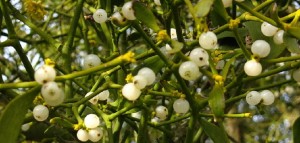
Mistletoe is generally thought of as a shrub or bush, but it is in fact a parasitic vine-like plant. Mistletoe attaches to its host plant by a structure called a haustorium, through which it absorbs nutrients.
While it may slow the growth of the host plant, it will only kill a host with a heavy infestation. The plant is actually hemi-parasitic, where the organism in question gets water and minerals from the host, but it still produces evergreen leaves that perform photosynthesis. It is unclear where the name comes from; there is a German relation between mist (dung) and tang (branch), but in Old English mistel was also used for basil. Mistletoe is present in Greek mythology, and it is believed to be the Golden Bough of Aeneas. The Druids taught that the mistletoe had qualities related to balancing one’s electromagnetic field, and herbalists have long tinctured the leaves and soft stems of the mistletoe plant for treating circulatory and respiratory problems. It has also been used to treat certain forms of cancer.
The custom of kissing under the mistletoe was described by American author Washington Irving in “The Sketch Book of Geoffrey Crayon” in 1820.




